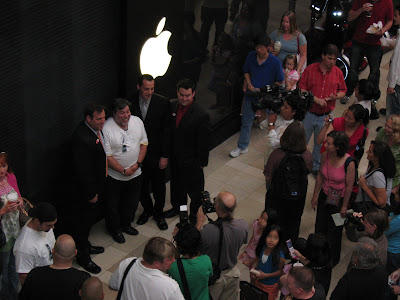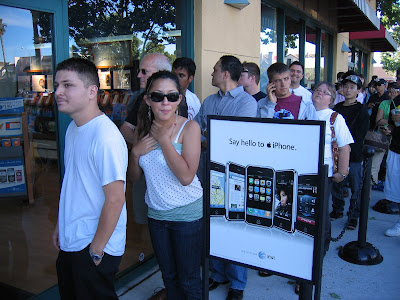iPhone tire kicking
So today I played with a real live iPhone, after visiting my 4th San José Cingular (AT&T) store in two days. I think the reviewers were pretty prescient but then I guess that’s their job.
Friday, people were walking out of the AT&T store with iPhones, but not today. Yes, one reason is that the store had sold out. But another reason is that the people who must have an iPhone — sleeping outside the door and all — went Friday and today it was idle tire-kickers like me. So if speculation is that they sold 250,000 phones yesterday, it’s less than 10% of that today.![[kiosk]](https://blogger.googleusercontent.com/img/b/R29vZ2xl/AVvXsEj9KU8itYgvK3v3elcd76wMcbk040HZn2YvxvvMbsWlzFvM3QW43iOsjwegUSceUJ0b4Sy1CoTQCkbYnIpL0ZCuSguvXNcwmheguumpgxiwMxcxeQFShyphenhyphenBBnEt6j5uqkeJWeLdeWe4vri8/s200/iPhoneDay2-Kiosk.jpeg) My local store had an iPhone-specific kiosk with a couple of college students who seemed (by cell phone store norms) pretty knowledgeable about the new toy. One guy did most of the demo had been trained for two weeks, but got his first real phone on Thursday.
My local store had an iPhone-specific kiosk with a couple of college students who seemed (by cell phone store norms) pretty knowledgeable about the new toy. One guy did most of the demo had been trained for two weeks, but got his first real phone on Thursday.
The biggest surprise was CoverFlow, the software by Jonathan del Strother that was bought by Apple last September for iTunes. With a touch screen, it’s really easy to flip through all the albums on your hard disk — like the old K-Tel style LP racks (except those were front to back and this is left to right). I couldn’t imagine a more natural way to browse through music, although it doesn’t seem like it would scale beyond 50 or 100 albums (i.e., I’d like to browse within a genre rather than the whole set).
The GUI for zooming/scrolling — with fingertip controls — was very natural. The virtual keyboard was not — supposedly it gets better with practice, but I certainly couldn’t get it to work in the 5 minutes I had to play with it; my experience is more like Steve Levy than Walt Mossberg. The portrait/landscape rotation was cool, but it seemed braindead (and un-Apple like) that it only works in some applications. Overall, the phone seemed pretty much like Mike & I were predicting: it’s a web browser with an iPod in it (that can be used to make phone calls). In fact, if you clue off of the main menu, Apple believes that the iPhone is a phone, e-mail device, web browser and iPod. (I’d need a better keyboard for an e-mail device).
Overall, the phone seemed pretty much like Mike & I were predicting: it’s a web browser with an iPod in it (that can be used to make phone calls). In fact, if you clue off of the main menu, Apple believes that the iPhone is a phone, e-mail device, web browser and iPod. (I’d need a better keyboard for an e-mail device).
However, the visit seemed to support one of the worst criticisms: slow data speed. The demo was done on the store’s Wi-Fi rather than AT&T’s EDGE network. People have been complaining about using the iPhone on EDGE since the day it was announced. There was a rumor that this month AT&T even accelerated its network with the “Fine Edge” program in anticipation of iPhone Day.
So the data service is slow, but they require everyone to sign up for data plans for $60-120/month? No matter how much spin you put on it, if a cell phone company doesn’t want to demo their cell phone network, that seems like a negative sign. It seems to support the criticisms of both neutral analysts and CDMA partisans that Apple chose the wrong network for the wrong reasons.
Clearly, the iPhone will raise the data ARPU for (what today is) one of the slowest data networks in the country. But how many net new additions will the iPhone bring: how many people will say (as I do) I’m only interested in the iPhone if I’m already a Cingular customer? Apparently I’m not the only one down on Cingular; as Bloomberg reported yesterday:
Cingular, which merged into San Antonio-based AT&T last year when AT&T bought BellSouth, rated below average in New York in a 2006 Consumer Reports survey of online subscribers' experiences with service gaps, busy circuits and static. It was last or next to last in overall customer satisfaction in 18 major cities; it tied for second out of four carriers in New York. …
AT&T is “kind of average,” says Richard Ellrodt, senior director for telecommunications and technology research at J.D. Power, a unit of New York-based McGraw-Hill Cos. “It doesn't have the worst score, but it doesn't have the best score.”







![[feed]](http://photos1.blogger.com/x/blogger2/6971/993546936938810/1600/z/962294/gse_multipart3851.gif)